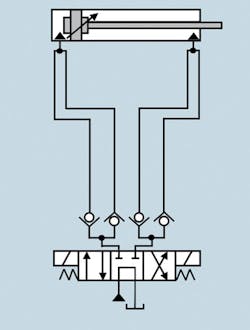The cylinder in the illustration represents one with such a small volume and that is so far from the directional valve that the lines to and from the cylinder hold more fluid than it does. Because fluid flowing out of the cylinder never reaches the directional valve, fresh fluid never cycles through the cylinder; it just flows into and out of the cylinder port repeatedly. The result is overheating, and all wear particles and contaminant ingested through the rod seal remain in the fluid until the cylinder fails prematurely.
The check valves can be installed anywhere in the lines, but the tee fittings should be as close as possible to the valve and cylinder ports.
This dual flow path circuit is even more important when the cylinder is mounted vertically with the rod up. Contamination lays on the piston and seals and can score the cylinder tube and cause premature seal wear when allowed to collect.
This information is excerpted from our eBook, Fluid Power Basics, which you can view for free on our website.


